NLP: The Three Perceptual Positions
Hello, this is Stalilingus! Let’s get straight to the point, friends. Today, we’ll talk about the three-position model in NLP—how to better understand yourself, others, how to get quality feedback, and how to improve your communication skills. Some of you might not immediately grasp the technical side, but practice makes perfect! Personally, I think this topic is for Jedi-level communicators. Let’s dive in!
The NLP Model of “Three Perceptual Positions”
The “Three Perceptual Positions” model (also known as “three positions of perception,” “positional shifts,” or “three-position perception”—call it what you like) is used for gathering information and evaluating communication situations. The model was borrowed from Virginia Satir. While many think it’s purely NLP, Satir actually laid the groundwork.
The Positions:
- First Position: “Self” – Association with yourself. You evaluate the situation from your own point of view.
- Second Position: “Other” – Association with another person. You “step into their shoes” and see things through their eyes.
- Third Position: “Observer” – Dissociation. You evaluate the situation as a qualified observer (or simply as an outsider).
- Fourth Position: “System” – A dislocated position that combines different systems, such as family, work, company, or the city you live in. The fourth position is a topic for another discussion—contact admin Pavluu if you want it covered.
First Perceptual Position
The first position means evaluating a situation from your own perspective, based on your interests and values. Although it seems simple, it’s not always easy—sometimes all three positions are “fused” in your mind, making it hard to separate your interests from those of others or from an outside perspective. People usually have a preferred way of evaluating situations.
In the first position, you speak in the first person: “It’s important for me to pass this exam.” Nonverbal cues include strong emotional reactions, more movement, and muscle tone. Think of people described as “self-centered” or “egoists”—they’re often stuck in the first position. These people are usually the first to save themselves in a crisis.
To enter the first position (if you’re not already in it), pay attention to your breathing, bodily sensations, and inner dialogue. Ask yourself: What am I thinking about?
Second Perceptual Position
The second position means “associating with another”—in this case, another participant in the interaction. If there are several participants, there can be several second positions. For example, in a conflict, you assess your own views from the first position, and then assess the same situation from your opponent’s perspective—from the relevant second position.
People in the second position are often very friendly or, conversely, negative—they either want to help you or make things difficult. You’ll often hear requests to take the second position: “Put yourself in their shoes,” “see it through their eyes,” “feel what they feel,” “look at it from their perspective,” or “walk a mile in their shoes.” The second position is about truly associating with the other person, not just logically analyzing them. It’s a way to use your unconscious mind to model someone else’s worldview. To access this information (or rather, to create it, since your unconscious generates it as needed), you need to clarify what you’re looking for.
Technique for Entering the Second Position:
- Develop your visualization skills.
- Imagine your spirit or perception leaving your body and merging with your opponent’s body.
- Visualize seeing everything through their eyes, imagine what they might feel, and what they might be thinking.
- That’s the second position.
Third Perceptual Position
The third position involves dissociating from the situation. Here, you act as an expert observer who can provide a balanced assessment and recommendations to the participants. The third position requires emotional detachment and a focus on analyzing the situation. You don’t take sides; instead, you analyze the process, relationships, and can offer advice on how to achieve goals—if the goal is defined. In the third position, you need to set the evaluation framework. For example, if you’re resolving a complex situation or negotiating, you focus on achieving mutual understanding in terms of values or outcomes.
Nonverbal cues for dissociation include a distant, “frozen” posture, low muscle tone, and weak emotional reactions. Often, people switch to a digital (analytical) mode with matching nonverbal signals.
Common phrases for entering the third position include: “Look at it from the outside,” or “step out of the situation.”
Technique for Entering the Third Position:
- Visualize yourself stepping out of your body (no need to get too mystical—just imagine it).
- Imagine that the one who stepped out is an expert in the situation.
- From this position, gather the information you need.
How to Use These Positions
Switch between positions to discover what you’re missing from the second position, what the second position wants, and from the third position, ask what’s needed to reach an agreement, and so on. It sounds simple. Try recalling a situation where you misunderstood someone and go through all three positions. The result may surprise you.
Yours, Stalilingus!



